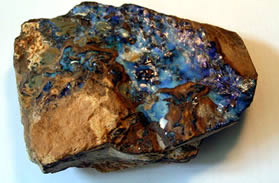NOTES ABOUT OPALS
The word “opal” comes from the Latin word “opalus” which means “ to see a change in colour”. Opal is made up of millions of tiny uniform spheres of transparent hard silica (sand), which fit together in an orderly three-dimensional frame, sitting in a bath of silica solution. Light passes through the transparent spheres in a direct line, but when it “hits” the bath of silica, it is bent and deflected at different angles; this is what produces all the different colours.
TYPES OF OPAL
 |
Black Opal Black opal is characterised by a dark body tone causing brightness of colour which is unmatched by lighter opals. It is mined in Lightning Ridge, New South Wales and is the most valuable and sought after type of opal. The term “black opal” does not mean that the stone is completely black but that the stone has a dark body tone ranging from dark grey to jet black. |
|
White Opal |
|
|
Boulder Opal |
|
 |
Doublet and Triplet Opal Doublets and triplets are partially man made stones, consisting of only a thin layer of stone cemented to a black backing. This is a doublet. Triplets have, in addition to this, a clear quartz or glass capping over the top to magnify the colour, protect the stone and give it a domed appearance |
 |
 |
LOOKING AFTER OPALS
Solids
Solid opals are fine in water and should be cleaned gently in a mild solution of detergent in warm water and a soft toothbrush or cloth. Avoid bleach, chemicals or cleaners.
Doublets and Triplets
Because doublets and triplets consist of layers, which are glued together, prolonged exposure to water will cause lifting between the layers and allow water to penetrate. If this happens the stone will take on a “grey” or “foggy” appearance. You should avoid getting a doublet wet.
Doublets and triplets may be cleaned by wiping over with damp, soft cloth and mild detergent but should NEVER be soaked or immersed.

The main opal fields are as follows: -
White Opal
This comes from South Australia. The three main fields are marked on the map and the busiest one in production is Coober Pedy.
Boulder Opal
This comes from Queensland and the two main working fields are marked on the map. The main field is Quilpie.
Black Opal
This comes from New South Wales and the most productive field is Lightning Ridge.
Examples of raw boulder opal before cutting and polishing:
 |
 |


